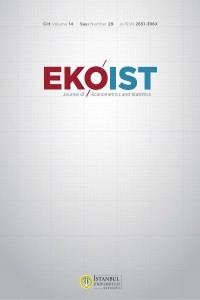Spatial Econometric Models and The Analysis of the Determinants of Internal Migration in Turkey
Spatial econometric models have become increasingly popular in economic studies, especially in recent years. These models differ from classical econometric models in that they take into account the effects arising from the location of the data set subject to the study. The spatial effect seen in a data set comes in two forms. The first form is spatial autocorrelation, which is defined as the correlation between neighboring locations. The other form is spatial heterogeneity, defined as the variance of a variable under consideration from place to place. The aim of this study was to find out whether the factors affecting provincial migration in Turkey have spatial characteristics. For this purpose, data from 2014 were selected as all data were accessible. A coherence matrix was constructed by considering the borders of the provinces to show the possible spatial relationship and this matrix was used in the econometric models. The distribution map of migration by province was examined and it was found that there was significant clustering, especially towards the northeast-southwest. From this point of view, the provinces where the spatial effect was significant in the clustered regions were identified using LISA statistics. The spatial model was determined in accordance with the orientation of the factors affecting migration and the movement of these variables was evaluated based on the provinces with significant correlation. The results obtained fit with the economic theory.
___
- Abar, H. (2011). Determinants of Intercity Migration of Turkey: Spatial Econometrics Approach, Ataturk University, Institute of Social Sciences, Department of Economics (Master Thesis)
- Anselin, L. (1988). Spatial Econometrics: Methods and Models (Vol. 4). Springer Science & Business Media.
- Anselin L., Gallo J.L., Jayet H. (2008). Spatial Panel Econometrics. In: Mátyás L., Sevestre P. (eds) The Econometrics of Panel Data. Advanced Studies in Theoretical and Applied Econometrics, vol 46. Springer, Berlin, Heidelberg.
- Anselin, L. (2002). Under the Hood İssues in the Specification and Interpretation of Spatial Regression Models, Agricultural Economics, 27:3,247-267.
- Akgis, O. (2015). Spatial Distribution of Happiness as a Well Being Indicator in Turkey. Turkish Geographical Review, 65, 69-76.
- Baltagi, B. H., Egger, P., and Pfaffermayr, M. (2013). A generalized spatial panel data model with random effects. Econometric Reviews, 32(5-6), 650-685.
- Blommestein, H. J. (1983). Specification and Estimation of Spatial Econometric Models: A Discussion of Alternative Strategies for Spatial Economic Modelling, Regional Science and Urban Economics,13:2,1983, 251-270.
- Cliff, A. and Ord, J.K. (1972). Testing for Spatial Autocorrelation among Regression Residuals, Geographic Analysis, 4:3,267-284.
- Doh, R. (1984). Inter-provincial Migration in Turkey and its Socio-economic Background: A Correlation Analysis, The Turkish Journal of Population Studies, 6, 49-61.
- Elhorst, J. P. (2001). Dynamic Models in Space and Time, Geographical Analysis, 33:2,119-140.
- Elhorst, J. P. (2010). Applied Spatial Econometrics: Raising the Bar, Spatial Economic Analysis, 5:1, 9-28.
- Ercilasun, M., Hic Gencer, E. A., Ersin, O.O. (2011). Modeling the Determinants of Internal Migration in Turkey, International Conference on Eurasian Economies, (Online) http://avekon.org/papers/378.pdf
- Fischer, M. M., and Wang, J. (2011). Spatial Data Analysis: Models, Methods and Techniques. Springer Science & Business Media.
- Frexedas, O. V. and Vaya, E. (2005). Financial Contagion Between Economies: An Exploratory Spatial Analysis, Estudios de Economia Aplicada, 23:1, 151- 165
- Geary, R. C. (1954). The Contiguity Ratio and Statistical Mapping, The Incorporated Statistician, 5:3, 1, 115-146.
- Getis, A. and Ord, J. K. (1992). An analysis of Spatial Association by Use of Distance Statistic, Geographical Analysis, 24:3, 189-206.
- Gumprecht, D. (2007). Spatial Methods in Econometrics: An Application to R&D Spillovers, WU Vienna University of Economics and Business, Doctoral Dissertation, (Online) http://epub. wu.ac.at/290/1/document.pdf
- Haining, R. P. (1990). Spatial Data Analysis in the Social and Environmental Sciences, Cambridge University Press.
- Hordijk, L. (1979). Problems in Estimating Econometric Relations in Space, Papers in Regional Science, 42:1, 99-115.
- Hordijk, L. and Paelinck, J. (1976). Some Principles and Results in Spatial Econometrics. Recherches Économiques de Louvain/Louvain Economic Review, 42:3, 175-198.
- Lesage, J. P. (1999). The Theory and Practice of Spatial Econometrics, University of Toledo, Ohio.
- Munro, J. M. (1974). Migration in Turkey, Economic Development and Cultural Change, 22:4, 634-653.
- Ozgur, E. M. and Aydin, O. (2011). The Evaluation of Marriage Migration Using Spatial Data Analysis Techniques In Turkey, Turkish Journal Of Geograpgical Sciences, 9, 29-40.
- Paelinck, J. H. (2013). Some Challenges for Spatial Econometricians. Acta Universitatis Lodziensis. Folia Oeconomica, 292, 11-20.
- Paelinck, J.H. and Klaassen, L. H. (1979) Spatial Econometrics, Farnborough: Saxon House.
- Pazarlioglu, V. (2007). Econometric Analysis of Internal Migration in İzmir Case, Yönetim ve Ekonomi Dergisi, 14:1, 121-135.
- Tunali, I. (1996). Migration and Remigration of Male Household Heads in Turkey, 1963-1973, Economic Development and Cultural Change, 45:1, 31-67.
- Yakar, M. (2012). Spatial Analysis of Internal Migration by Districts in Turkey: 1995-2000 Period, International Journal of Human Sciences, 9:1,741-768.
- Yamak, N. And Yamak, R. (1999). Türkiye'de Gelir Dağılımı ve İç Göç, Dokuz Eylul University The Journal of Graduate School of Social Sciences, 1:1, 16-28.
- Viton, P. A. (2010). Notes on Spatial Econometric Models, City and Regional Planning, 870:3, 1-23.
- (Online) https://www.tkdk.gov.tr/Content/File/Yayin/Rapor/Aricilikv2.pdf
- (Online) http://www.aricilik.info/aricilik-bilgileri/aricilik/ariciligin-tarihcesi-ve-gelismesi.html
- Yayın Aralığı: Yılda 2 Sayı
- Yayıncı: İstanbul Üniversitesi
